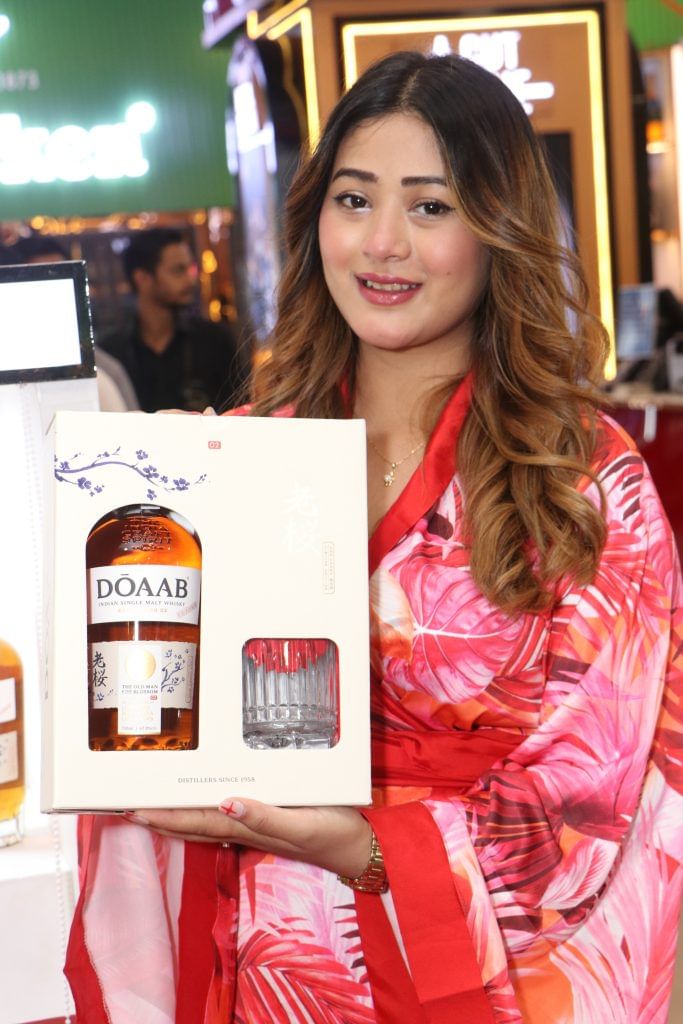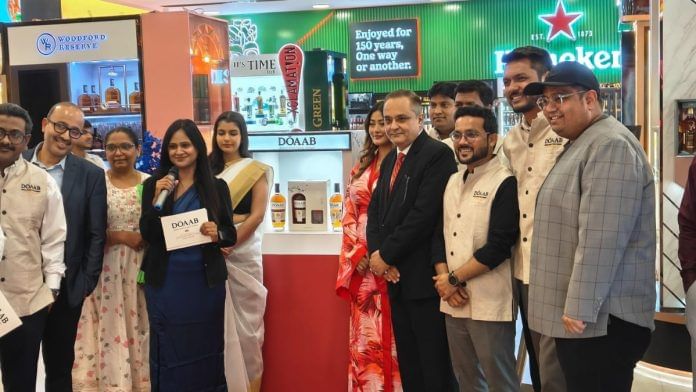New Delhi: In Gurgaon’s spacious single-storied shop, The Liquor Warehouse at MG Road, two models—one dressed in a kasavu saree and another in a kimono—were posing next to a table. They were part of the prop at the launch of a “limited edition” whisky. The packaged whisky was placed inside a small square-shaped white box with a curtain atop the table, flanked by the two ‘live’ models.
The curtain parted to reveal the bottle embossed with blue cherry blossoms, or sakura as they are called in Japan, an integral symbol of Japanese culture. However, its barley has been procured from Sri Ganganagar in Rajasthan, creating a fusion that is targeted at the ever-burgeoning single-malt whisky market of India.
With this launch, Doaab Expression 02: The Old Man and the Blossom joined a growing list of home-grown premium single malt brands that are trying to take a pie of a segment that’s witnessing high growth.
India’s luxury single malt whisky has been growing in awards, consumer base and storytelling over the last few years, with its projected market size around $300 million in 2025. India has also created the highest growth in total beverage alcohol consumption among 20 key global markets for the third consecutive half-year period. Earlier this year, Indri was named Best World Whisky at the Las Vegas Global Spirits 2025. Godawan is another single malt Indian brand that boasts numerous awards on its label. The whiskey was even launched in the US last year to give it a truly global appeal. It is distilled in Alwa, Rajasthan.
“Whisky is an aspirational drink. A young man who sees his father drink dreams of sharing a drink with his father. And Indian single-malt brands are catching up on this with innovation and creativity. There is a push for innovation. Godawan took the sustainability route by using local ingredients, while Doaab brought in the Mizunara cask of Japan,” said Nitin Tewari, founder, Bar Kala Academy.
Beyond the push of a new breed of entrepreneurs wanting to establish India’s dominance in the global single malt industry lies an important import that’s helping the makers sustain this success story.
“Homegrown luxury focuses on storytelling about its origins and cask finishes, used to age whisky. Weather conditions in India make ageing difficult, so the brands have to rely on the variety of casks,” said Angad Gandhi, a luxury spirits consultant.
That is why Indri opted for the Marsala casks from Italy’s Sicily, which render a sweet, complex and sometimes nutty taste to its whisky. Mizunara casks, on the other hand, give fruity notes, like apples and pears.
Localised target and global storytelling
The Mizunara oak of Hokkaido is one of the rarest and most expensive oaks in the world, and is associated with luxury spirits. Just its name on a label can mean a jump in the pricing of the spirit matured in its casks. A mizunara tree can grow for 200 years before it is large enough to make into casks. Each cask can cost around $6,000.
Globus Spirits has sourced the casks before distilling its liquor and creating a limited edition of 500 casks. The price of each 750 ml bottle stands at Rs 5,000 in Haryana. The product will soon be launched in Goa and Maharashtra as well.
“People, especially Gen Z or even millennials, now do not pay for alcohol. They pay for experience, and as a liquor brand, we have to constantly upgrade ourselves to deliver it. Now, young people drink less, but they want limited editions,” said Rajesh Fanda, business head, consumer division of Globus Spirits.

That is why storytelling is crucial to a brand’s selling point. And Globus has brought Japan to its Rajasthan grown 46-row barley, creating a combination not seen before in single malt whisky.
“The people in their late 20s-40s are the segment that are making the whisky-drinking culture grow. Towns like Lucknow, Indore and Chandigarh, along with metro cities, are driving it,” said Gandhi.
The name Dōaab, derived from the Hindi words ‘dō’ (two) and ‘aab’ (water), refers to the fertile land between two rivers. The brand’s first limited-edition release, 01 Six Blind Men and the Elephant, took inspiration from the iconic Indian fable. Crafted entirely in 100 per cent ex-bourbon barrels, this single malt whisky is a testament to meticulous craftsmanship and collaboration. It, too, was limited to just 500 casks and pays homage to the collective effort of those who contributed to its creation.
The bottle’s packaging had motifs inspired by Rajasthan’s mandana art. It won India Whisky of the Year at the Berlin International Spirits Competition 2025. It clinched Silver at the International Spirits Challenge 2025 in London and a bronze at the London Spirits Competition 2025. It has been hailed as the Indian Single Malt Whisky of the Year 2025 in India.
“Awards are being marketed by the brands to get a larger consumer base. From trying to connect local culture and traditions to their product to pop-ups, chef’s tables and food pop-ups, all of it is helping the brands in the marketing,” said Gandhi.
Also read: Sunny Leone and Delhi’s dal makhani are inseparable
The Japanese influence
Over the years, Japanese influence has caught up with Indian youngsters, with an increased curiosity about the country’s culture, food and beverages. This has been reflected not only in Doaab’s latest alcohol, but also in food and beverage trends across metros. At Doaab’s launch, the two models dressed in Indian and Japanese attire emphasise the coming together of the two ancient civilisations of Japan and India.
“The number of Indians travelling to Japan has increased, and people have eaten their food, experienced the local culture and are now looking to experience it back home,” said chef Adwait Anantwar of Inja, the World’s first Indian-Japanese fusion restaurant in New Delhi. Inja’s customers are diplomats, businessmen and individuals who are aware of world cuisine and have questions about how fusion is created in the menu.
While Inja is creating a revolution through its Alaskan king crab raj kachori and lobster rasam chawanmushi, Globus Spirits has extended it to alcohol.
Globus Spirits, which created Dooab, had spent more than three and a half years, from procurement of the rare Mizunara casks to distilling and finally releasing its whisky. It also helps that Japanese whisky is known as a premium and exceptional segment in the world of whiskies.
“Earlier, it was about the countries, and now it’s about the cask finish, ageing and taste profile. India is still in a very early stage, discovering and consuming single malt, but is moving towards premium alcohol. What has changed is the eagerness to know more about the alcohol they are drinking, and for it to be exclusive. That’s why the bottles are now collector’s items,” said Tewari.
(Edited by Saptak Datta)






